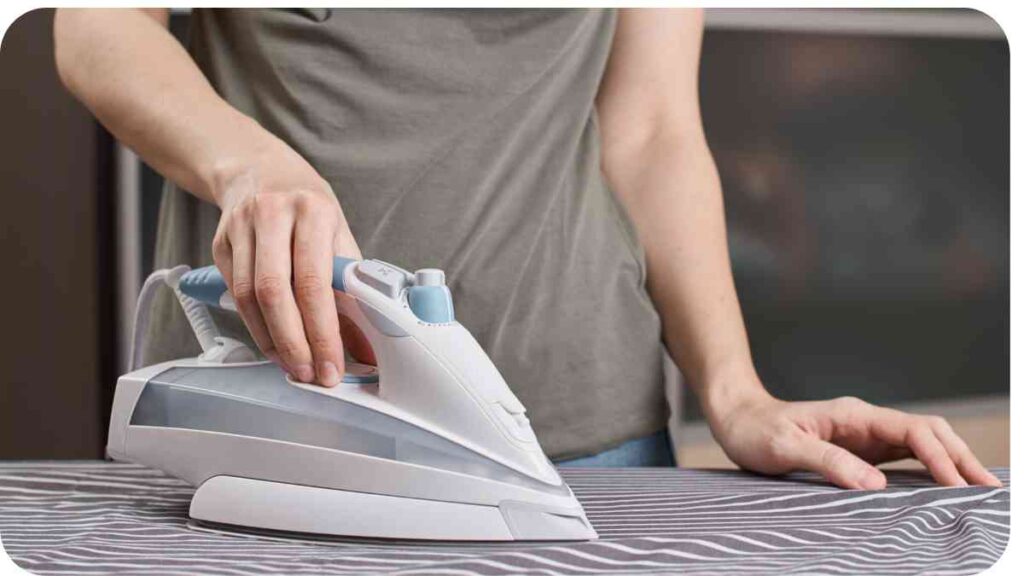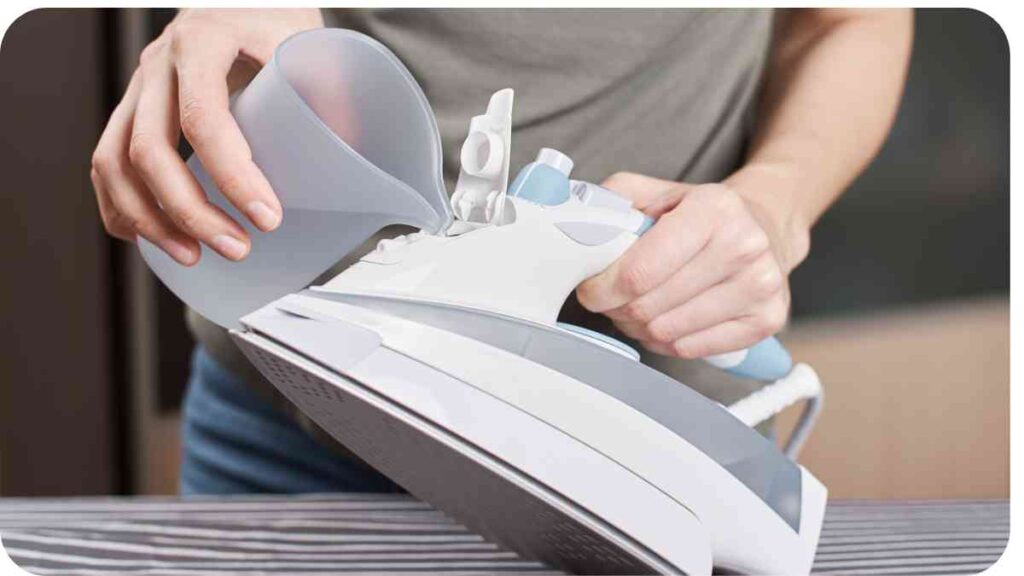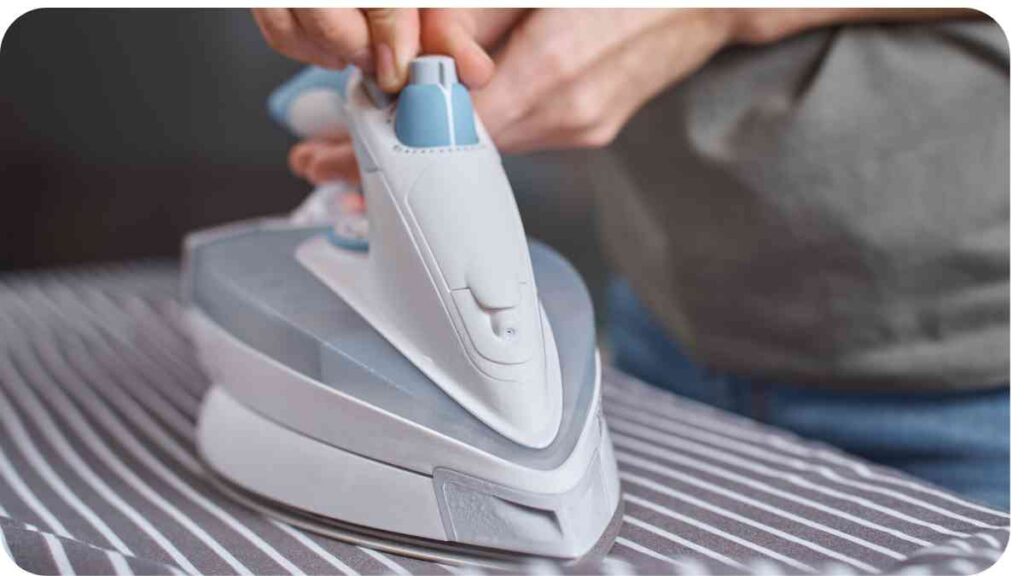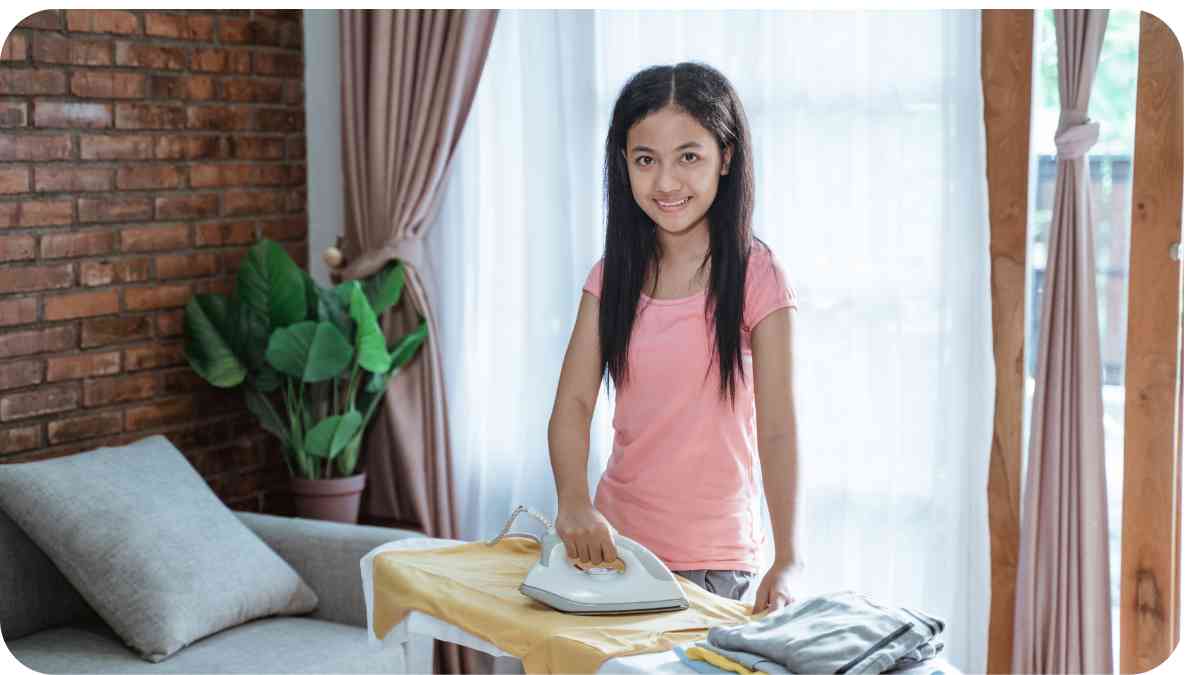Welcome to our troubleshooting guide for clothes irons. Ironing clothes is a common household task, and like any other appliance, irons can encounter issues that may disrupt your ironing routine. In this article, we will discuss some common problems you may experience with your clothes iron and provide practical solutions to fix them.
Whether you’re dealing with an iron that isn’t heating up, water leakage, uneven heating, or a sticking soleplate, we’ve got you covered.
| Takeaways |
|---|
| Proper troubleshooting can help resolve common problems with clothes irons. |
| Regular maintenance, such as cleaning the soleplate and descaling the iron, is essential for optimal performance. |
| Choosing the right iron with features like adjustable steam settings and a quality soleplate can make a difference in your ironing experience. |
| Follow proper ironing techniques for different fabrics to avoid damage. |
| Practice safety precautions to ensure a safe ironing environment. |
| Storage and handling of the iron should be done with care to prevent damage. |
| Grouping ironing tasks and using pressing cloths can enhance efficiency and protect delicate fabrics. |
| For more in-depth information, refer to the provided resources for troubleshooting and additional tips. |
2. Understanding the Clothes Iron

Before delving into troubleshooting, it’s essential to understand the basic components of a clothes iron. A typical iron consists of a handle, a water tank, a thermostat, a heating element, and a soleplate.
The handle provides a comfortable grip, the water tank enables steam functionality, the thermostat controls the temperature, the heating element converts electrical energy into heat, and the soleplate is the flat surface that comes into contact with the fabric.
Ensure seamless stitching with our guide on troubleshooting your sewing machine. Discover common issues and effective fixes for a hassle-free sewing experience
3. Common Problems with Clothes Irons
Let’s explore some of the common issues that you may encounter with your clothes iron and learn how to address them effectively.
3.1. Iron Not Heating Up
One frustrating problem is when your iron fails to heat up. This can be due to various reasons, such as a faulty power connection, a malfunctioning thermostat, or a damaged heating element.
3.2. Water Leakage
Water leakage is another issue that can occur, especially if you use the steam function frequently. If you notice water dripping from the iron or excessive steam production, it’s essential to identify the source of the leakage and find a solution.
Maintain pristine whites effortlessly! Dive into our quick and easy guide on removing stains from white clothes. Keep your wardrobe looking fresh and stain-free.
3.3. Uneven Heating
Uneven heating is a common problem that can leave creases and wrinkles on your clothes. It can be caused by mineral deposit buildup on the soleplate, thermostat inaccuracies, or poor heat distribution.
3.4. Sticking Soleplate
A sticking soleplate can be frustrating as it causes the iron to drag or even damage delicate fabrics. This issue usually arises due to residue buildup from fabric coatings or the use of the iron at too high a temperature.
Table 3.1: Common Problems with Clothes Irons
| Problem | Possible Causes |
|---|---|
| Iron Not Heating Up | Faulty power connection, thermostat, or heating element |
| Water Leakage | Issues with the steam function or water tank |
| Uneven Heating | Mineral deposits, thermostat inaccuracies, or poor heat distribution |
| Sticking Soleplate | Residue buildup or excessive heat |
4. Troubleshooting Guide: How to Fix Common Iron Issues
In this section, we will provide you with practical solutions to fix the common problems that may arise with your clothes iron.
4.1. Iron Not Heating Up Solutions
If your iron is not heating up, there are a few steps you can take to resolve the issue:
- Check the power connection: Ensure that the iron is properly plugged into a functioning electrical outlet.
- Inspect the thermostat: If the thermostat is not functioning correctly, it may be preventing the iron from heating up. Consider replacing it if necessary.
- Examine the heating element: A damaged or faulty heating element can cause the iron to stop heating. Consult a professional for repairs or consider replacing the iron if the heating element cannot be fixed.
Elevate your shoe care routine with our comprehensive guide on how to clean suede shoes. Uncover effective tips and tricks for preserving the beauty of your suede footwear.
4.2. Water Leakage Solutions
To address water leakage from your iron, try the following:
- Check the water tank: Ensure that the water tank is securely attached to the iron without any visible cracks or damage.
- Clean the iron: Mineral deposits can accumulate and cause blockages that lead to leakage. Use a mixture of vinegar and water to descale the iron and remove any deposits.
- Inspect the steam vents: Blocked steam vents can cause water to leak. Use a needle or toothpick to clear any blockages carefully.
- Check the gasket: If the gasket is worn or damaged, it may need to be replaced. Consult the iron’s user manual or contact the manufacturer for guidance on obtaining a replacement gasket.
4.3. Uneven Heating Solutions

To tackle the issue of uneven heating, consider the following solutions:
- Clean the soleplate: Mineral deposits and fabric residue can accumulate on the soleplate over time, leading to uneven heating. Use a damp cloth or a soleplate cleaner to remove any buildup.
- Calibrate the thermostat: If you suspect a thermostat inaccuracy, consult the iron’s user manual for instructions on how to calibrate it properly.
- Ensure proper heat distribution: Ironing boards with metal mesh tops can impede heat distribution. Consider using a heat-reflective ironing board cover to promote uniform heat transfer.
4.4. Sticking Soleplate Solutions
For a sticking soleplate, try the following solutions:
- Clean the soleplate: Residue from fabric coatings or starch buildup can cause the soleplate to stick. Use a soleplate cleaner or a mixture of vinegar and water to remove the residue.
- Adjust temperature settings: Using the iron at excessively high temperatures can cause the soleplate to stick to fabrics. Lower the temperature to the appropriate setting for the fabric you are ironing.
- Avoid applying excessive pressure: Applying too much pressure when ironing can cause the soleplate to stick. Allow the weight of the iron to glide over the fabric naturally.
Say goodbye to styling woes! Explore our quick guide on troubleshooting common hair straightener issues. Achieve salon-quality results with ease.
Table 4.1: Troubleshooting Solutions for Common Iron Issues
| Problem | Solutions |
|---|---|
| Iron Not Heating Up | – Check the power connection<br>- Inspect the thermostat<br>- Examine the heating element |
| Water Leakage | – Check the water tank<br>- Clean the iron<br>- Inspect the steam vents<br>- Check the gasket |
| Uneven Heating | – Clean the soleplate<br>- Calibrate the thermostat<br>- Ensure proper heat distribution |
| Sticking Soleplate | – Clean the soleplate<br>- Adjust temperature settings<br>- Avoid applying excessive pressure |
5. Maintenance Tips to Keep Your Iron in Good Shape
To ensure the longevity and optimal performance of your clothes iron, it’s important to follow proper maintenance practices. Here are some tips to keep your iron in good shape:
5.1. Cleaning the Soleplate
Regularly cleaning the soleplate of your iron is crucial to maintain its effectiveness. Here’s how you can do it:
- Ensure the iron is unplugged and completely cooled down.
- Dampen a cloth with a mixture of mild dish soap and water.
- Gently scrub the soleplate to remove any residue or buildup.
- For stubborn stains, you can use a soleplate cleaner or a paste made from baking soda and water.
- Wipe the soleplate clean with a damp cloth and then thoroughly dry it.
5.2. Descaling the Iron
Over time, mineral deposits can accumulate inside your iron, affecting its performance and causing water leakage. Descaling your iron periodically helps remove these deposits. Follow these steps:
- Fill the water tank halfway with a mixture of equal parts white vinegar and water.
- Turn on the iron and set it to the highest steam setting.
- Place the iron upright on a heat-resistant surface and allow it to steam for about 5-10 minutes.
- Turn off the iron and empty any remaining liquid from the water tank.
- Fill the tank with plain water and repeat the steaming process to flush out any vinegar residue.
- Wipe the soleplate and allow the iron to cool down before using it again.
5.3. Storing the Iron Properly
Proper storage prevents damage and helps maintain the functionality of your iron. Here are some guidelines:
- Ensure the iron is completely cooled before storing.
- Wrap the cord loosely and avoid kinks or bends that could damage it.
- Store the iron in an upright position to avoid scratching the soleplate or any other surfaces.
- If possible, dedicate a separate space for storing the iron to prevent it from being knocked over or damaged by other objects.
Unlock the secrets to flawless ironing! Dive into our guide on troubleshooting your flat iron. Learn essential tips and fixes for maintaining a perfectly pressed wardrobe.
5.4. Avoiding Overuse
Using your iron excessively can cause wear and tear. Here’s how you can avoid overuse:
- Iron only when necessary, and consider grouping your ironing tasks together to minimize the frequency of heating up and cooling down the iron.
- Follow the recommended temperature settings for different fabrics to prevent overheating and protect delicate materials.
- Use a pressing cloth or an ironing mat when working with delicate fabrics to prevent direct contact between the iron and the fabric.
Table 5.1: Maintenance Tips for a Well-Maintained Iron
| Maintenance Tip | Description |
|---|---|
| Cleaning the Soleplate | Regularly clean the soleplate with mild dish soap and water or a soleplate cleaner |
| Descaling the Iron | Periodically descale the iron to remove mineral deposits using a vinegar and water solution |
| Storing the Iron Properly | Store the iron in an upright position in a dedicated space to prevent damage |
| Avoiding Overuse | Use the iron sparingly, follow recommended temperature settings, and use a pressing cloth for delicate fabrics |
6. Expert Advice and Recommendations
As an expert in the field of ironing, I would like to share some additional advice and recommendations to help you make the most out of your clothes iron and achieve perfectly pressed garments.
6.1. Choosing the Right Iron

Investing in a high-quality iron can make a significant difference in your ironing experience. Consider the following factors when choosing an iron:
- Wattage: Higher wattage irons tend to heat up faster and maintain a more consistent temperature, making ironing more efficient.
- Steam Functionality: Look for an iron with a powerful steam function and adjustable steam settings for better wrinkle removal.
- Soleplate Material: Nonstick ceramic or stainless steel soleplates glide smoothly over fabrics and are easier to clean.
- Weight and Grip: Opt for an iron that is comfortable to handle and not too heavy for extended ironing sessions.
6.2. Ironing Techniques for Different Fabrics
Different fabrics require special care when ironing to avoid damage. Here are some general guidelines for ironing common fabrics:
- Cotton: Use a high temperature setting and steam to eliminate wrinkles effectively.
- Silk: Set your iron to a low temperature or use a silk setting to prevent damaging delicate silk fibers.
- Wool: Use a cool iron or place a damp cloth between the iron and the wool to prevent heat damage.
- Synthetic Fabrics: Use a low or medium temperature setting to avoid melting or scorching.
Always refer to the garment care labels for specific ironing instructions and adjust your techniques accordingly.
6.3. Safety Precautions
It’s essential to practice safety precautions to prevent accidents and ensure a safe ironing experience:
- Always unplug the iron when not in use and before cleaning or refilling it.
- Never leave a hot iron unattended and keep it out of reach of children and pets.
- Use a heat-resistant ironing board or surface and avoid placing the hot iron on unstable or flammable surfaces.
- Be cautious with the steam function to prevent burns, and direct the steam away from your body and others.
6.4. Ironing Tips and Tricks
Consider these additional tips and tricks to enhance your ironing experience:
- Sort your clothes by fabric type and iron them in batches to maintain a consistent heat level.
- Pre-mist fabric with water or use a spray bottle to lightly dampen stubborn wrinkles.
- Start ironing delicate or embellished areas first and leave the larger surface areas for last.
- Iron dark-colored fabrics inside out to prevent any potential shine or scorch marks.
- Hang ironed clothes immediately to prevent new wrinkles from forming.
Remember, practice makes perfect when it comes to ironing. As you continue to gain experience, you’ll develop your own techniques and find what works best for you.
7. Conclusion
In this troubleshooting guide for clothes irons, we discussed common problems that you may encounter, such as the iron not heating up, water leakage, uneven heating, and a sticking soleplate. We provided practical solutions to resolve these issues and keep your iron in good working condition.
Additionally, we shared maintenance tips to help you clean and descale your iron, store it properly, and avoid overuse. Following these guidelines can extend the lifespan of your iron and ensure optimal performance.
We also provided expert advice on choosing the right iron, ironing techniques for different fabrics, safety precautions, and some additional ironing tips and tricks to enhance your ironing experience.
Remember, while troubleshooting and maintenance can often resolve common iron issues, if you face more complex problems or are unsure about performing repairs, it’s always best to consult a professional or contact the manufacturer for assistance.
With the information and recommendations provided in this guide, you’ll be well-equipped to tackle any iron-related challenges and achieve perfectly pressed clothes.
Happy ironing!
Further Reading
Here are some additional resources that provide more information on iron troubleshooting, maintenance, and ironing tips:
- Common Dry Iron Problems and Solutions: This article discusses common issues with dry irons and provides practical solutions to address them.
- Iron Press Not Working: Common Causes and Solutions: If you’re facing issues with your iron press, this resource explains the possible causes and offers solutions to troubleshoot the problem.
- How to Fix Common Ironing Problems: This guide covers various ironing problems and provides step-by-step solutions to resolve them effectively.
FAQs
Here are some frequently asked questions about iron troubleshooting and maintenance:
What should I do if my iron is not heating up?
If your iron is not heating up, ensure that it is properly plugged in and the thermostat is functioning correctly. You may also need to check the heating element for any damage or consider replacing it.
How can I prevent water leakage from my iron?
To prevent water leakage, make sure the water tank is securely attached, clean the iron regularly to remove mineral deposits, and ensure the steam vents are not clogged. If the gasket is worn or damaged, it may need to be replaced.
How do I fix uneven heating in my iron?
To address uneven heating, clean the soleplate to remove any residue, calibrate the thermostat if possible, and ensure proper heat distribution by using a heat-reflective ironing board cover or changing your ironing technique.
How do I prevent my iron’s soleplate from sticking to fabrics?
To prevent sticking, clean the soleplate regularly to remove residue, adjust temperature settings to the appropriate level for the fabric, and avoid applying excessive pressure while ironing.
How often should I descale my iron?
The frequency of descaling depends on the hardness of your water and the frequency of use. However, descaling every few months or as soon as you notice mineral buildup is a good general guideline.
Please note that these answers serve as a general guide, and it’s important to refer to your specific iron’s user manual or contact the manufacturer for precise instructions and information.

Hi, you! I’m Hellen James. I’m a beauty and fashion writer who loves to make the world a little more stylish and I’d love for you to join me in the fun! I’ve been writing about beauty and fashion since I was a kid, but it wasn’t until recently that I really knew what it meant to be a real expert.

